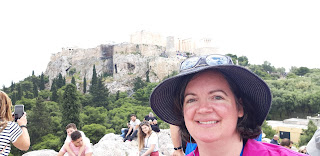Saturday, May 11, 2019
On the evening of the first full day of our cruise, we arrived in Patmos.
Patmos is a small island of about 13 square miles, about 40 miles off of the Turkish coast.
Patmos is home to 3,000 people, although this fluctuates to 1,500 in February and 15,000 in August. Our tour guide recommended September as a good time to plan a trip to Patmos, as the icy waters have warmed some, and the crowds of tourists have thinned considerably. There are three main villages on Patmos, and the capital city is Hora. The tiny nearby island of Farafi, which is only reached by private boats, boasts three taverns and one church for its whopping five residents.
Patmos' greatest attraction is its historical significance to the Christian church, as it is the island to which John the Disciple was exiled by Domitian around 95 AD (over 1,900 years ago!), and holds a cave where John received and wrote down Jesus' revelation to him for the seven churches in Asia Minor - including the church in Ephesus. Patmos is mentioned in Revelation 1:9. John was more than 90 years old at the time, and according to church tradition was accompanied by a young volunteer named Procolos, who wrote down John's words using a stone ledge for a desk in the cave while John reclined on the floor (where there is a silver-lined space where he is said to have laid his head, a silver-framed crevice in the rock he used for a hand grip, and a crack in the rock above caused by Jesus coming to stand in that place. Each venerated place is slick from the pressing hands, foreheads and lips of thousands of pilgrims. The Church of the Apocalypse was built across the mouth of the cave, and was later expanded into a larger church, a monastery and a school for young monks, and even a gift shop which is there today.
Almost every holy site we visit, we see the somewhat distressing tendency of our forefathers to build, and build, and build some more atop a historic site. I guess it's our human response to the holy, trying to contain it somehow, even as Peter said after experiencing Christ's Transfiguration, that they should set up a building and dwell there. I wonder that we don't marvel more at the Living Lord's presence within us, His footprint on our very lives, as He dwells within us by His Holy Spirit. It is incredible to realize, that as believers, we are the temple of the living God. We don't have to memorialize what He has done in us before, as He is always at work, and completing the good and perfect work which He has begun.
After visiting the Cave of Revelation and the compound around it, we sat in the shade along a rock wall, and listened as Pastor Ted spoke with us about how the book of Revelation should encourage us as a church today. He shared some thoughts from Dennis Johnson who had shown him that Revelation was less about giving us a timetable fore the end times, and more about encouraging and empowering believers in Jesus as we face our own spiritual conflicts every day. What is written below is from Pastor Ted's teaching notes.
1. Revelation helps Christians see our situation in its true perspective. We are to walk by faith and not by sight The paradox of the slaughtered Lamb as the raging Lion of Judah remind us that in our weakness, God is overwhelmingly strong.
2. Revelation shows our enemies in their true colors. While Satan is stronger and savvier than we are, he is an already beaten foe. While he can still persecute, deceive and seduce - he does not win.
3. Revelation reveals our champion in his true glory. Jesus is our glorious champion, and we will see him in all His might and glory when He returns.
4. R
evelation enables us to see ourselves in our true beauty. Even though we still battle against our sin nature, Rev shows us that our Bridegroom loves us and will not rest until He presents us to Himself "as a bride adorned for her husband" (21:2)
In light of these truths, we are to endure through the inevitable suffering we will experience, to stay pure amidst temptation, and to bear witness as we await God's victorious return.
We then walked to the top of the island, where St. Christolos had built a monastery to honor St. John in 1008 (931 years ago), on the site of what was once a Temple to Artemis, the fortified walls dating back to Greek and Roman periods before Christ. In that monastery is a 6th Century partial copy of the Gospel of Mark. The monastery was also a place of refuge for the islanders, from the dangers of pirates.
 |
| What a beautiful, and sacred place |
 |
| Standing at an overlook on the top of Patmos at the Monastery of St. John |
 |
| The kneading trough for the monk's bread making duties. Imagine, making, and KNEADING this much bread dough! |














































